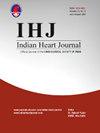Long-term outcome of variety of techniques used to stabilize left ventricular lead in difficult coronary sinus anatomy- A single centre experience
IF 1.4
Q3 CARDIAC & CARDIOVASCULAR SYSTEMS
引用次数: 0
Abstract
Introduction
Difficult coronary sinus (CS) anatomy may lead to difficulty in optimal left ventricular (LV) lead placement and lead displacements leading to nonresponse to cardiac resynchronization therapy (CRT).
Methods
In this retrospective study, we studied the CRT parameters of devices implanted by single operator during the time period from January 2014 till December 2021, where different off-label techniques were used to place/stabilize LV lead. The technique used to stabilize LV lead, CRT parameters at baseline and follow up were noted for each patient.
Results
Out of 133 CRTs implanted during the study period, 23 patients (17.29 %) required off-label techniques. Stylet and guidewire retaining techniques were used in 11/23 (47.82 %) and 7/23 (30.43 %) patients respectively. In two patients, LV lead was jailed using coronary stent to prevent displacement. Two patients had CS stenosis and required balloon dilation while one patient had tortuous posterolateral vein which was straightened using a coronary stent. There was technical failure of 6/23 LV leads (26.08 %) with loss of capture, at a median follow up of 44 months (Range: 06–114 months). Out of these 6 patients, stylet and guidewire retaining techniques were used in 4 and 2 patients respectively.
Conclusion
Despite having acceptable parameters at implantation, these techniques particularly stylet and guidewire retention, may lead to non-capture of LV lead on long term follow ups. Better LV leads like active fixation leads and conduction system pacing (His Bundle/left bundle branch pacing) should be preferred in difficult CS anatomy.
在冠状动脉窦解剖困难的情况下采用各种技术稳定左心室导联的长期效果--单中心经验。
导言:困难的冠状窦(CS)解剖可能导致左心室(LV)导联置入困难和导联移位,从而导致心脏再同步化治疗(CRT)无反应:在这项回顾性研究中,我们研究了 2014 年 1 月至 2021 年 12 月期间由单一操作者植入的设备的 CRT 参数,这些设备采用了不同的标签外技术来放置/稳定左心室导联。我们记录了每位患者用于稳定左心室导联的技术、基线和随访时的 CRT 参数:在研究期间植入的 133 个 CRT 中,有 23 名患者(17.29%)需要使用标签外技术。11/23(47.82%)和7/23(30.43%)例患者分别使用了支架和导丝保留技术。两名患者使用冠状动脉支架固定左心室导线以防止移位。两名患者的 CS 狭窄,需要进行球囊扩张,一名患者的后外侧静脉迂曲,使用冠状动脉支架将其拉直。在中位随访 44 个月(范围:06 -114 个月)时,有 6/23 个左心室导联(26.08%)出现技术故障,无法捕获。在这 6 名患者中,分别有 4 名和 2 名患者使用了支架和导丝保留技术:结论:尽管这些技术在植入时具有可接受的参数,但在长期随访中可能会导致左心室导联无法捕获,尤其是支架和导丝保留技术。在CS解剖困难的情况下,应首选更好的左心室导联,如主动固定导联和传导系统起搏(His束/左束支起搏)。
本文章由计算机程序翻译,如有差异,请以英文原文为准。
求助全文
约1分钟内获得全文
求助全文
来源期刊

Indian heart journal
CARDIAC & CARDIOVASCULAR SYSTEMS-
CiteScore
2.60
自引率
6.70%
发文量
82
审稿时长
52 days
期刊介绍:
Indian Heart Journal (IHJ) is the official peer-reviewed open access journal of Cardiological Society of India and accepts articles for publication from across the globe. The journal aims to promote high quality research and serve as a platform for dissemination of scientific information in cardiology with particular focus on South Asia. The journal aims to publish cutting edge research in the field of clinical as well as non-clinical cardiology - including cardiovascular medicine and surgery. Some of the topics covered are Heart Failure, Coronary Artery Disease, Hypertension, Interventional Cardiology, Cardiac Surgery, Valvular Heart Disease, Pulmonary Hypertension and Infective Endocarditis. IHJ open access invites original research articles, research briefs, perspective, case reports, case vignette, cardiovascular images, cardiovascular graphics, research letters, correspondence, reader forum, and interesting photographs, for publication. IHJ open access also publishes theme-based special issues and abstracts of papers presented at the annual conference of the Cardiological Society of India.
 求助内容:
求助内容: 应助结果提醒方式:
应助结果提醒方式:


